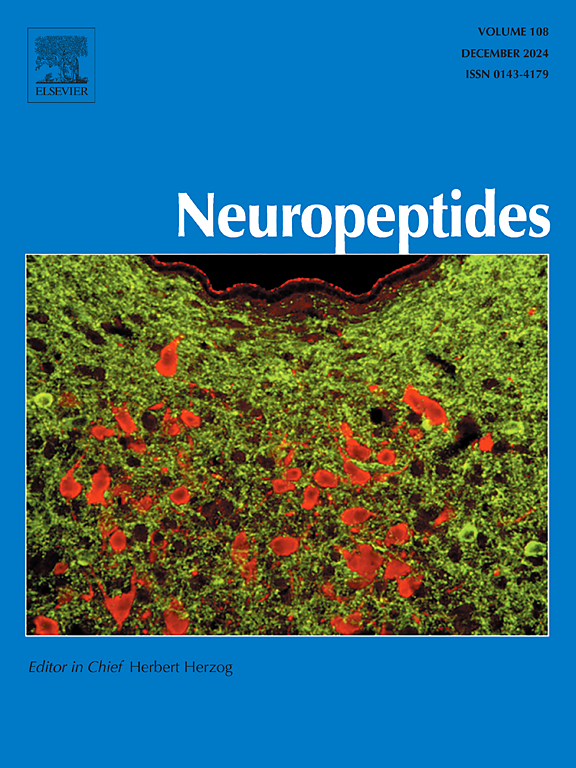内源性N/OFQ对DPN的影响:对大鼠下肢血流调节的研究
IF 2.7
3区 医学
Q3 ENDOCRINOLOGY & METABOLISM
引用次数: 0
摘要
糖尿病周围神经病变(DPN)是糖尿病的常见并发症,常伴有下肢血管内皮功能受损。这种功能障碍的特点是血管舒张反应降低,导致下肢血流量减少,最终导致糖尿病周围神经病变的发展。为了深入研究这一病理过程,本研究采用生物信息学方法对DPN中高活性的基因进行了鉴定和分析。研究发现,膜金属内肽酶(MME)拮抗剂能有效减轻其活性。以雄性SD大鼠为研究对象,系统探讨了痛觉/孤儿蛋白FQ-N/OFQ受体(N/OFQ- nop)系统、下肢股动脉血流、MME和DPN之间的内在联系。随机分为对照组和单次腹腔注射链脲佐菌素(STZ) 55 mg/kg诱导DPN组,每组6只。研究结果表明,与对照组相比,DPN组的股动脉血流明显减少。与此同时,血清N/OFQ浓度显著升高,下肢股动脉组织中阿片相关伤害性蛋白受体1 (OPRL1)和MME表达升高,坐骨神经刺激阈值升高。上述结果提示,DPN大鼠血清N/OFQ水平升高,可能通过上调MME,降低外周血流分布,促进周围神经病变的发生。本文章由计算机程序翻译,如有差异,请以英文原文为准。
The impact of endogenous N/OFQ on DPN: Insights into lower limb blood flow regulation in rats
Diabetic peripheral neuropathy (DPN) is a common complication of diabetes, often accompanied by impaired vascular endothelial function in the lower limbs. This dysfunction is characterized by a reduced vasodilatory response, leading to decreased blood flow in the lower limbs and ultimately contributing to the development of diabetic peripheral neuropathy. To delve deeper into this pathological process, the study employed bioinformatics to identify and analyze genes highly active in DPN. The investigation revealed that Membrane metallo-endopeptidase (MME) was effectively mitigated by its antagonist. Male Sprague-Dawley (SD) rats served as the model to systematically explore the intrinsic connection among the nociceptible/orphanin FQ-N/OFQ receptor (N/OFQ-NOP) system, femoral artery blood flow in the lower extremities, MME, and DPN. The rats were randomized into two groups: a control group and a DPN group induced by a single intraperitoneal injection of 55 mg/kg streptozotocin (STZ), with 6 rats in each group. The findings indicated that compared to the control group, the DPN group exhibited a significant reduction in femoral artery blood flow. This was accompanied by a notable increase in serum N/OFQ concentration, heightened expression of opioid-related nociceptive protein receptor 1 (OPRL1) and MME in femoral artery tissues of the lower limbs, and an elevated sciatic nerve stimulation threshold. These results suggest that the serum N/OFQ level in DPN rats is increased, which may promote the occurrence of peripheral neuropathy by up regulating MME and reducing peripheral flow distribution.
求助全文
通过发布文献求助,成功后即可免费获取论文全文。
去求助
来源期刊

Neuropeptides
医学-内分泌学与代谢
CiteScore
5.40
自引率
6.90%
发文量
55
审稿时长
>12 weeks
期刊介绍:
The aim of Neuropeptides is the rapid publication of original research and review articles, dealing with the structure, distribution, actions and functions of peptides in the central and peripheral nervous systems. The explosion of research activity in this field has led to the identification of numerous naturally occurring endogenous peptides which act as neurotransmitters, neuromodulators, or trophic factors, to mediate nervous system functions. Increasing numbers of non-peptide ligands of neuropeptide receptors have been developed, which act as agonists or antagonists in peptidergic systems.
The journal provides a unique opportunity of integrating the many disciplines involved in all neuropeptide research. The journal publishes articles on all aspects of the neuropeptide field, with particular emphasis on gene regulation of peptide expression, peptide receptor subtypes, transgenic and knockout mice with mutations in genes for neuropeptides and peptide receptors, neuroanatomy, physiology, behaviour, neurotrophic factors, preclinical drug evaluation, clinical studies, and clinical trials.
 求助内容:
求助内容: 应助结果提醒方式:
应助结果提醒方式:


